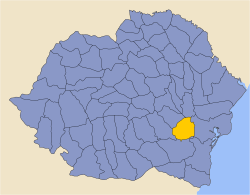Top Qs
Timeline
Chat
Perspective
Brăila County
County of Romania From Wikipedia, the free encyclopedia
Remove ads
Brăila County (Romanian pronunciation: [brəˈila] ⓘ) is a county (județ) of Romania, in Muntenia, with the capital city at Brăila.
Remove ads
Demographics
At the 2021 Romanian census, Brăila County had a population of 281,452 (172,533 people in urban areas and 108,919 people in rural areas.) and the population density was 59.1/km2 (152.9/sq mi).[2]
Remove ads
Geography
This county has a total area of 4,766 km2 (1,840 sq mi).
All the county lies on a flat plane: the Bărăgan Plain, one of the best areas for growing cereals in Romania.
On the east side there is the Danube, which forms an island – the Great Brăila Island –surrounded by the Măcin channel, Cremenea channel, and Vâlciu channel. On the northern side there is the Siret River and on the north-western side there is the Buzău River.
Neighbours
- Tulcea County in the east.
- Buzău County in the west.
- Galați County and Vrancea County in the north.
- Ialomița County and Constanța County in the south.
Remove ads
Economy
The agriculture is the main occupation in the county. Industry is almost entirely concentrated in the city of Brăila. The predominant industries in the county are:
- Food industry.
- Textile industry.
- Mechanical components industry.
In Brăila there is an important harbour, once the biggest cereal harbour in Romania.
Tourism

The main tourist destinations are:
- The city of Brăila.
- The Lacu Sărat resort.
Politics
The Brăila County Council, renewed at the 2020 local elections, consists of 30 counsellors, with the following party composition:[5]
Remove ads
Administrative divisions


Brăila County has 1 municipality, 3 towns, and 40 communes
- Communes
- Bărăganul
- Berteștii de Jos
- Bordei Verde
- Cazasu
- Chiscani
- Ciocile
- Cireșu
- Dudești
- Frecăței
- Galbenu
- Gemenele
- Grădiștea
- Gropeni
- Jirlău
- Mărașu
- Măxineni
- Mircea Vodă
- Movila Miresii
- Racovița
- Râmnicelu
- Romanu
- Roșiori
- Salcia Tudor
- Scorțaru Nou
- Siliștea
- Stăncuța
- Surdila-Găiseanca
- Surdila-Greci
- Șuțești
- Tichilești
- Traian
- Tudor Vladimirescu
- Tufești
- Ulmu
- Unirea
- Vădeni
- Victoria
- Vișani
- Viziru
- Zăvoaia
Remove ads
Historical county
Summarize
Perspective
Historically, the county was located in the southeastern part of Greater Romania, in the northeastern part of the Muntenia region. Its territory included the portions of the current county to the east and south-east of the Buzău River. It was bordered on the west by the counties of Buzău and Râmnicu-Sărat, to the north by Covurlui County, to the east by Tulcea County, and to the south by the counties of Constanța and Ialomița.
Administration

The county was originally divided administratively into four districts (plăși):[6]
- Plasa Călmățui, with headquarters at Făurei
- Plasa Ianca, with headquarters at Ianca
- Plasa Silistraru, with headquarters at Silistraru
- Plasa Viziru, with headquarters at Viziru
Subsequently, Plasa Călmățui, was abolished and two new districts were established in its place:
Population

According to the 1930 census data, the county population was 219,831 inhabitants, ethnically divided as follows: 89.4% Romanians, 3.1% Jews, 2.2% Greeks, 0.7% Hungarians, 0.6% Russians, as well as other minorities.[7] From the religious point of view, the population was 93.6% Eastern Orthodox, 3.3% Jewish, 1.2% Roman Catholic, as well as other minorities.[8]
Urban population
In 1930, the county's urban population was 68,347 inhabitants, comprising 75.4% Romanians, 9.7% Jews, 6.7% Greeks, 1.7% Hungarians, 1.6% Russians, as well as other minorities.[7] Mother tongues among the urban population were Romanian (82.6%), Greek (5.8%), Yiddish (4.8%), Russian (1.9%), Hungarian (1.5%), as well as other minorities. From the religious point of view, the urban population was composed of 84.4% Eastern Orthodox, 10.4% Jewish, 3.2% Roman Catholic, as well as other minorities.[8]
Remove ads
References
Wikiwand - on
Seamless Wikipedia browsing. On steroids.
Remove ads







